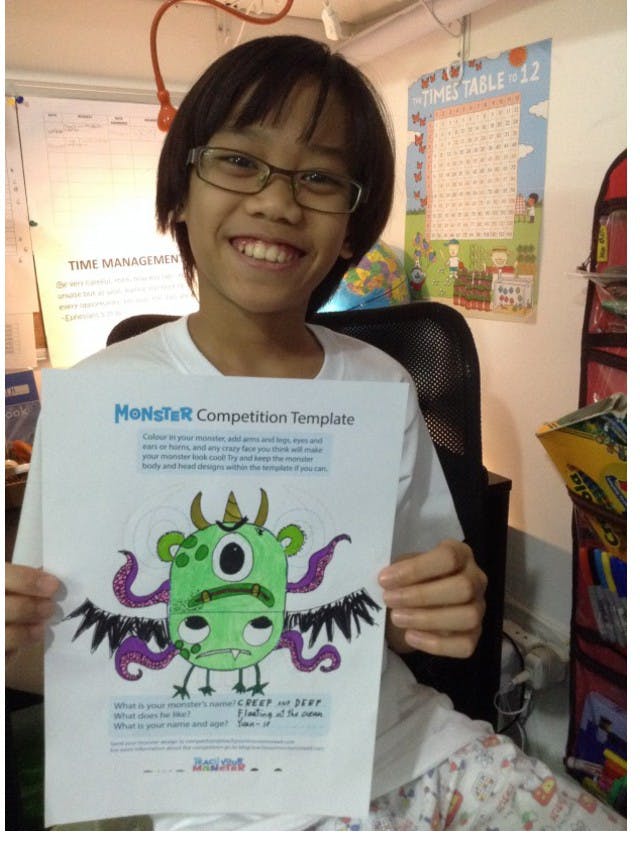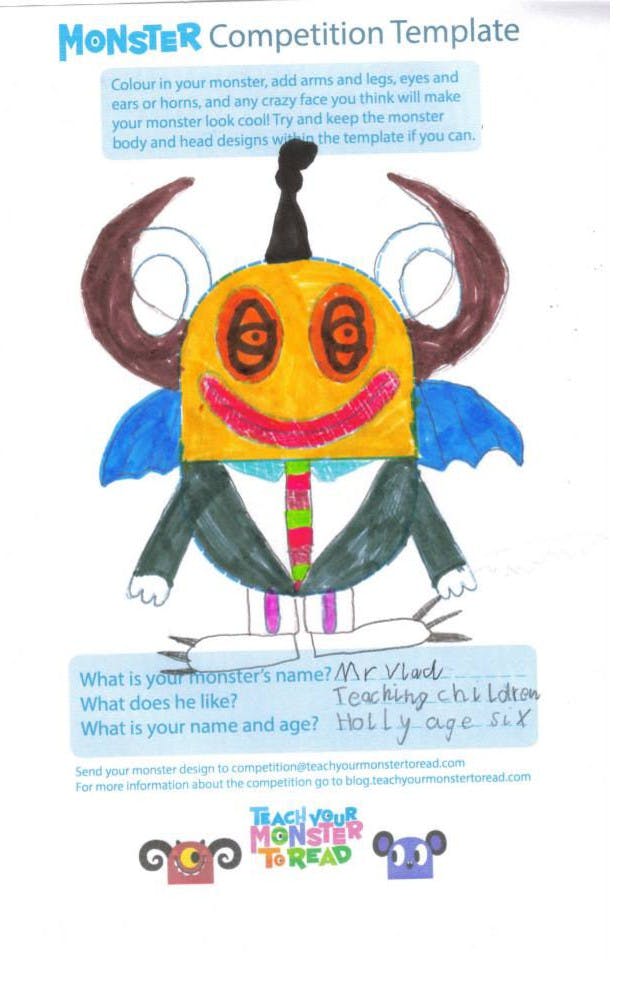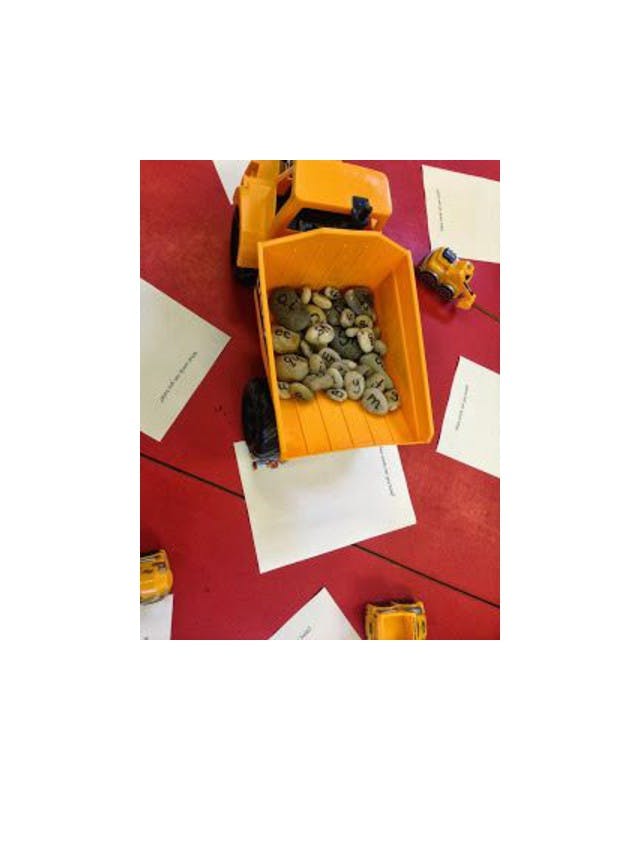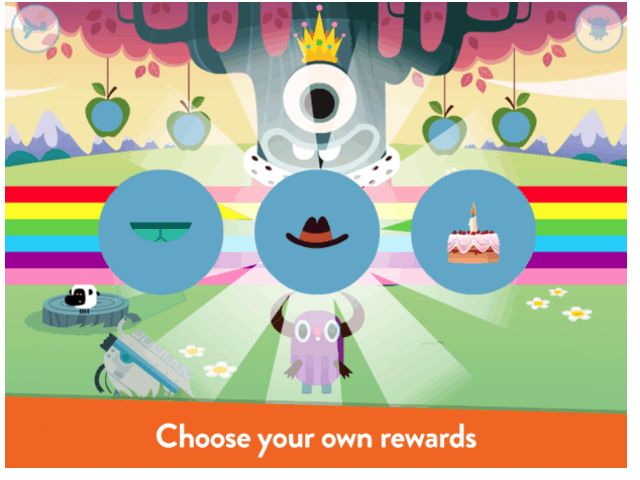
Thanks to this image on Stacey Adams Pinterest page and the fantastic Meaningful Mama blog for the idea of using bubble wrap as a phonics game.
It’s simple; add sticky labels containing target words or graphemes. Say the word out loud and ask children to find the words and if they get it right they can pop the bubble.
You can also try blending words together by adding letters to the bubble wrap and asking children to pop the right bubble to the corresponding sound.
It’s an easy game to set up and we know that lots of children love popping bubble wrap! Read how to set it up on the Meaningful Mama blog page.

A quick and easy phonics activity that helps children practice blending and segmenting. Use it every day with different letter blocks.
Head over to Mrs Ostermans’ blog for more ideas and resources on the ‘shake a day’ theme.
Send over any phonics games or resources you use at home or in the classroom and we’ll feature them on this blog.
The winner of our Draw a Monster competition for Summer 2014 is… Yuan with his drawing of ‘Creep and Deep’.

‘Creep and Deep’ is green and likes ‘Floating at the ocean’. We love that he has two faces, wings and four tentacles.
Yuan wins £150 worth of Usborne books for his school. Congratulations Yuan!
Runners up in the competition were Holly from Scotland and also Lucas from South Korea. (Teach Your Monster to Read is truly international!)
Holly drew the colourful and original ‘Mr Vlad’. ‘Mr Vlad’ likes teaching children. Here he is below in all his vampiric glory.
Lucas drew ‘Mr Grandpa’. ‘Mr Grandpa likes dancing! He also has a marvellous beard that impressed the judging panel.
Well done Lucas and Holly! You will each receive £75 worth of Usborne books for your schools.


Thank you to Micaela and Mary-Anne and the team at Kideeko for judging the game and to Teach Your Monster to Read’s illustrator Rich Wake for making the final selection!
All the entries to the competition can be found in this Facebook gallery. Thank you to everyone who entered. The monsters were out of this world!
It’s here! We’re delighted to announce that Teach Your Monster To Read: First Steps is now available as an iPad app.
Download the Teach Your Monster to Read iPad app from the Apple App Store today!
All the functions and features of the web game are there – children create a monster, and take it on a fantastic adventure through a magical world where they meet island kings and collect letters to win prizes, developing speed and accuracy of letter recognition along the way.
Just as with the web version, the Teach Your Monster To Read: First Steps iPad app is designed for children aged 3 – 6 years old. We hope the app is used by parents and teachers alike, in and around the house, in classrooms, on the move and everywhere in between.
You can email us [email protected], or drop us a message on Facebook or Twitter. We’d love to see pictures of the app in action.
Teach Your Monster To Read for iPad is available from the Apple App Store, priced at £2.99/$4.99. All proceeds go to the Usborne Foundation, helping support new games and ideas for Teach Your Monster To Read, as well as other learning and literacy projects.
More questions? Head over to teachyourmonstertoread/ipad
Help us spread the word! Tell your friends about our brand new iPad app.

It’s a great one for those children who love diggers! (We know a few of those here at Teach Your Monster to Read!)
Children put different pebbles together to practise blending and segmenting with different grapheme-phoneme correspondences.
This game can be easy to play using simple letter sounds or made more challenging by writing words on the pebbles so children can create sentences.It’s a great one for those children who love diggers! (We know a few of those here at Teach Your Monster to Read!)
Children put different pebbles together to practise blending and segmenting with different grapheme-phoneme correspondences.
This game can be easy to play using simple letter sounds or made more challenging by writing words on the pebbles so children can create sentences.
With all the same functionality and features that children loved about the online game, this iPad version will be just as fun and educational, helping young children to practise the initial steps of reading.
Teach Your Monster to Read: First Steps phonics app is built on the principles of synthetic phonics and follows the teaching sequence in the “Letters and Sounds” programme
The game develops children’s speed and accuracy of letter recognition by taking them on a fantastic adventure through a magical world where they meet island kings and collect letters to win prizes. It also explores blending and segmenting, and introduces “tricky” words in a fun, interactive setting. It is aimed at beginning readers, both those who are on track and those who need more support.
Teach Your Monster to Read: First Steps app features the voice of Simon Farnaby from BBC’s Horrible Histories.
Teach Your Monster to Read: First Steps app will be priced at £2.99/$4.99. The web-based version for computers of Teach Your Monster to Read games 1 and 2 (First Steps and Fun with Words) remains available to anyone for free.
Proceeds from the app support further literacy-focussed charitable initiatives from the Usborne Foundation.
To register your interest in hearing about the Teach Your Monster to Read: First Steps please email [email protected]





Exciting news from Teach Your Monster to Read!
We’re pleased to announce that Teach Your Monster to Read: First Steps will launch on iPad this month. With all the same functionality and features that your little monsters loved about the online game, this iPad version will be just as fun and just as educational, introducing young children to the initial steps to reading.

Our monster fans have been asking about the iPad version for a few months now and we’re really excited to tell you that it’s on it’s way. We can’t wait to hear what you think!
Keep watching the Teach Your Monster to Read blog, Facebook and Twitter pages for further announcements.
Teach Your Monster to Read would like to see your monsters!

How to Enter
Print the MONSTER TEMPLATE, colour it in and add some monstrous features, such as arms and legs, eyes, a mouth, teeth, ears, belts, bows, hair – any parts your monster might want or need.
Send in a photograph of your monster with the first name and age of the entrant to [email protected].
We will add all our entries to the Teach Your Monster to Read Facebook page so you can see all these wonderful monsters together.
The Prize
The winner will receive £150 worth of Usborne books for their school and a Teach Your Monster to Read T-Shirt.
Three runners up will each receive £75 worth of Usborne books for their school.
Judging and deadline
Entries will be judged by the illustrator Rich Wake (our wonderful Teach Monster illustrator) and the website Kideeko – full of great tips and advice for bringing up a family.
The closing date to submit entries is 21st July 2014. Terms and Conditions for the competition can be found here: Competition Terms and Conditions
Good Luck! We can’t wait to see your monsters!
Teach Your Monster to Read is now on the UK’s Department for Education website along with other well regarded phonics resources.
Take a look at the DfE Guidance: Phonics self-assessment form: Teach Your Monster to Read.


Play this simple letter sound matching game that helps children match the phonemes to their corresponding graphemes.
Ask the children to call out the name of the object on the image and then the letter sound and match the right ones together.
This is fun way to introduce the different letter-sounds.
For more information on how to play and create this activity go to the Teaching Mama blog.














